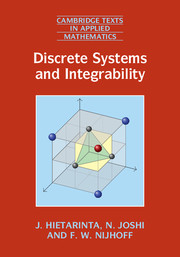Book contents
- Frontmatter
- Dedication
- Contents
- Preface
- 1 Introduction to difference equations
- 2 Discrete equations from transformations of continuous equations
- 3 Integrability of P∆Es
- 4 Interlude: Lattice equations and numerical algorithms
- 5 Continuum limits of lattice P∆E
- 6 One-dimensional lattices and maps
- 7 Identifying integrable difference equations
- 8 Hirota's bilinear method
- 9 Multi-soliton solutions and the Cauchy matrix scheme
- 10 Similarity reductions of integrable P∆Es
- 11 Discrete Painlevé equations
- 12 Lagrangian multiform theory
- Appendix A Elementary difference calculus and difference equations
- Appendix B Theta functions and elliptic functions
- Appendix C The continuous Painlevé equations and the Garnier system
- Appendix D Some determinantal identities
- References
- Index
5 - Continuum limits of lattice P∆E
Published online by Cambridge University Press: 05 September 2016
- Frontmatter
- Dedication
- Contents
- Preface
- 1 Introduction to difference equations
- 2 Discrete equations from transformations of continuous equations
- 3 Integrability of P∆Es
- 4 Interlude: Lattice equations and numerical algorithms
- 5 Continuum limits of lattice P∆E
- 6 One-dimensional lattices and maps
- 7 Identifying integrable difference equations
- 8 Hirota's bilinear method
- 9 Multi-soliton solutions and the Cauchy matrix scheme
- 10 Similarity reductions of integrable P∆Es
- 11 Discrete Painlevé equations
- 12 Lagrangian multiform theory
- Appendix A Elementary difference calculus and difference equations
- Appendix B Theta functions and elliptic functions
- Appendix C The continuous Painlevé equations and the Garnier system
- Appendix D Some determinantal identities
- References
- Index
Summary
We consider in this chapter the continuum limits of the lattice equations, i.e. the limiting equations (typically differential equations) that we retrieve from the discrete equations by shrinking the lattice grid to a continuous set of values corresponding to spatial and temporal coordinates. Having discussed in Chapter 3 the integrability aspects of quadrilateral P∆Es it is now in order to see what these equations are, and whether they can be identified as discrete analogues or discretizations of PDEs.
In numerical analysis the conventional picture is the one where discrete equations, namely finite-difference schemes, are used as numerical approximations to differential equations. The choice of difference schemes is sought on the basis of a variety of criteria such as numerical stability and speed of convergence. In most cases the continuum limit itself is a reductive procedure: we lose the lattice grid parameters by performing the limit. One major philosophical question in this picture is whether the differential equation is an approximation of a given discrete equation, or conversely, whether it is the finite-difference equation that plays the role of an approximation.
It is our perspective that continuum limits of discrete equations are the degenerations and approximations of the latter. One would expect, therefore, that the continuous equations are less rich in parameters than the discrete ones. In studying continuum limits of integrable discrete systems, however, it turns out that the latter is only partially true. We will observe that in some respects we do not really lose the “richness” of the relevant equations, as long as we keep intact the structure of parameter families of compatible equations. In their most explicit form the discrete equations can be shown to generate entire infinite families of continuous differential equations, which constitute the hierarchies associated with the famous soliton systems.
In practice we should perform continuum limits in such a way that integrability is retained at all levels. We will find that continuum limits are not necessarily unique, because starting from a two-dimensional P∆E, we can separately perform a continuum limit in each direction, leading in first instance to semi-continuous (semi-discrete) equations.
How to take a continuum limit
In a continuum limit involving a step-size parameter, say h, the difference operator ∆hy, defined in (1.9), will tend to a derivative, namely by (1.8), as was explained in Section 1.1.2.
- Type
- Chapter
- Information
- Discrete Systems and Integrability , pp. 136 - 158Publisher: Cambridge University PressPrint publication year: 2016

